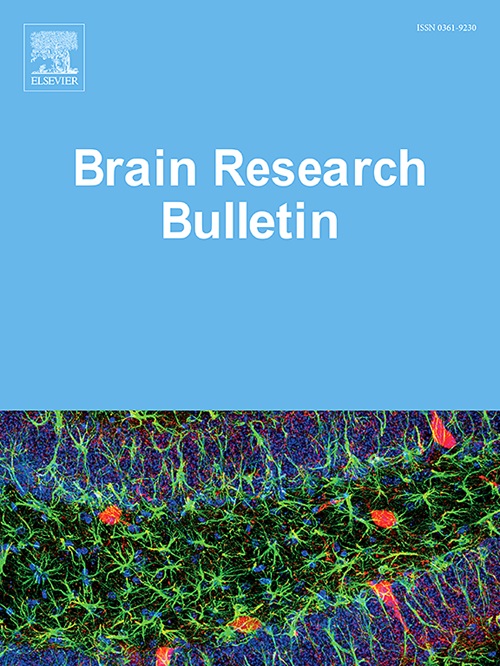m6A-modified lncRNA GAS5 promotes M1-polarization of microglia in alcohol use disorder
IF 3.5
3区 医学
Q2 NEUROSCIENCES
引用次数: 0
Abstract
Long noncoding RNA (lncRNA) are essential for modulating the onset and progression of alcohol use disorder (AUD). In this study, we investigated the molecular pathways through which lncRNA may contribute to AUD development. We assessed the expression levels of long noncoding RNA GAS5 (lncRNA GAS5) and microRNA-136–5p (miR-136–5p) in AUD tissue samples and cell lines using reverse transcription-quantitative polymerase chain reaction. Detection of GAS5 N6-methyladenosine (m6A) modifications, facilitated by alkylation repair homolog 5 (ALKBH5), was performed using RNA immunoprecipitation and RNA pull-down assays. The effect of GAS5 on the functionality of SH-SY5Y cells was evaluated using CCK-8 and Transwell assays. Our findings showed high levels of GAS5 expression in both AUD tissues and cell lines. Overexpression of GAS5 decreased the migratory capability of SH-SY5Y cells, whereas silencing GAS5 increased this ability. Bioinformatics analyses predicted a relationship between expression levels of miR-136–5p and GAS5, which was subsequently confirmed using dual-luciferase reporter assays. Additionally, we discovered that GAS5 acts as a sponge for miR-136–5p, leading to the upregulation of ATF2. Elevated levels of ATF2 are associated with M1 microglial polarization. In summary, m6A-modified GAS5 may influence the M1 polarization of microglia via the miR-136–5p/ATF2 pathway. Statistical evaluations were performed using GraphPad Prism V8.0, employing the student's t-test for comparisons between two groups, assuming a normal distribution and equal variances. When variances were unequal, but normality was maintained, the corrected Student's t-test was applied. The non-parametric Wilcoxon rank-sum test was used to analyze non-normally distributed data, and one-way ANOVA was used to compare three or more groups. Independent replication was ensured in the studies, with each experiment repeated at least three times and statistical significance was set at P < 0.05.
m6a修饰的lncRNA GAS5促进酒精使用障碍小胶质细胞m1极化。
长链非编码RNA (lncRNA)对于调节酒精使用障碍(AUD)的发生和进展至关重要。在这项研究中,我们研究了lncRNA可能促进AUD发展的分子途径。我们使用逆转录-定量聚合酶链反应评估了长链非编码RNA GAS5 (lncRNA GAS5)和microRNA-136-5p (miR-136-5p)在AUD组织样本和细胞系中的表达水平。采用RNA免疫沉淀法和RNA下拉法检测烷基化修复同源物5 (ALKBH5)介导的GAS5 n6 -甲基腺苷(m6A)修饰。采用CCK-8和Transwell法评价GAS5对SH-SY5Y细胞功能的影响。我们的研究结果显示,在AUD组织和细胞系中,GAS5的表达水平都很高。过表达GAS5降低了SH-SY5Y细胞的迁移能力,而沉默GAS5则增加了这种能力。生物信息学分析预测了miR-136-5p和GAS5表达水平之间的关系,随后使用双荧光素酶报告基因试验证实了这一点。此外,我们发现GAS5作为miR-136-5p的海绵,导致ATF2上调。ATF2水平升高与M1小胶质细胞极化有关。综上所述,m6a修饰的GAS5可能通过miR-136-5p/ATF2途径影响小胶质细胞的M1极化。采用GraphPad Prism V8.0进行统计评价,两组比较采用学生t检验,假设呈正态分布,方差相等。当方差不相等,但保持正态性时,应用校正后的学生t检验。非正态分布数据的分析采用非参数Wilcoxon秩和检验,三组及以上数据的比较采用单因素方差分析。研究保证独立重复,每个实验至少重复3次,P值为统计学显著性
本文章由计算机程序翻译,如有差异,请以英文原文为准。
求助全文
约1分钟内获得全文
求助全文
来源期刊

Brain Research Bulletin
医学-神经科学
CiteScore
6.90
自引率
2.60%
发文量
253
审稿时长
67 days
期刊介绍:
The Brain Research Bulletin (BRB) aims to publish novel work that advances our knowledge of molecular and cellular mechanisms that underlie neural network properties associated with behavior, cognition and other brain functions during neurodevelopment and in the adult. Although clinical research is out of the Journal''s scope, the BRB also aims to publish translation research that provides insight into biological mechanisms and processes associated with neurodegeneration mechanisms, neurological diseases and neuropsychiatric disorders. The Journal is especially interested in research using novel methodologies, such as optogenetics, multielectrode array recordings and life imaging in wild-type and genetically-modified animal models, with the goal to advance our understanding of how neurons, glia and networks function in vivo.
 求助内容:
求助内容: 应助结果提醒方式:
应助结果提醒方式:


